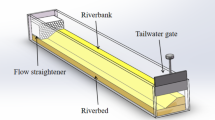Abstract
Here, we show for one of the Dutch Rhine River branches that large-scale riverine ecosystem rehabilitation and related vegetation succession may lead to up to 0.6 m higher river flood levels, because of increased hydraulic roughness. We hydraulically modeled future succession stages of embanked floodplain vegetation, following from present ecosystem rehabilitation plans for the 124-km-long river IJssel, and found flood levels exceeding the safety levels (related to dike heights). Our models take into account river engineering measures that are presently carried out, aimed at enhancing the river discharge capacity in order to meet required safety standards. Our study shows that there is a pressing need for integrated hydraulic-ecological evaluation of river engineering measures and ecosystem rehabilitation plans in the Rhine embanked floodplains. An important conclusion also is that hydraulic evaluation of planned vegetation goals only is inadequate, because flow resistance of preceding succession stages may be higher.




Similar content being viewed by others
Notes
Details of the Room for the River project are still subject to changes. For some locations along the IJssel alternative measures with roughly equal flood water-level effects are under study and definitive decisions on these measures still have to be taken. In our study we included some alternatives that we consider likely to be carried out. We included, for example, the ‘Bypass Kampen’, a flood diversion in the IJssel delta area, which is an alternative for channel deepening in this area. Such choices between alternative measures do not affect the conclusions reached.
References
Anonymous. 2009. User’s guide WAQUA, version 10.54. Directorate-General for Public Works and Water Management, The Netherlands. http://www.helpdeskwater.nl/Extra_applicaties/Simona/release/doc/usedoc.html. Accessed 2 July 2010.
Baptist, M.J., W.E. Penning, H. Duel, A.J.M. Smits, G.W. Geerling, G.E.M. van der Lee, and J.S.L. van Alphen. 2004. Assessment of the effects of cyclic floodplain rejuvenation on flood levels and biodiversity along the Rhine River. River Research and Applications 20: 285–297.
Cowan, W.L. 1956. Estimating hydraulic roughness coefficients. Agricultural Engineering 37: 473–475.
Directorate-General for Public Works and Water Management. 2006. Tentative river management review standard for interventions in the Rhine branches, version 10 April 2006. Arnhem, The Netherlands: Rijkswaterstaat DON (in Dutch).
European Commission. 2002. Commission working document on Natura 2000. http://ec.europa.eu/environment/nature/natura2000/index_en.htm. Accessed 2 July 2010.
European Commission. 2007. Council Directive 92/43/EEC of 21 May 1992 on the conservation of natural habitats and of wild fauna and flora. Consolidated version 1.1.2007. http://ec.europa.eu/environment/nature/legislation/habitatsdirective/index_en.htm. Accessed 2 July 2010.
European Commission. 2010. Directive 2009/147/EC of the European Parliament and of the Council of 30 November 2009 on the conservation of wild birds (codified version). http://ec.europa.eu/environment/nature/legislation/birdsdirective/index_en.htm. Accessed 2 July 2010.
Fathi-Maghadam, M., and N. Kouwen. 1997. Nonrigid, nonsubmerged, vegetative roughness on floodplains. Journal of Hydraulic Engineering 123: 51–57.
Klaassen, G.J., and J.J. van der Zwaard. 1974. Roughness coefficients of vegetated flood plains. Journal of Hydraulic Research 12: 43–63.
Klijn, F., M. van Buren, and S.A.M. van Rooij. 2004. Flood-risk management strategies for an uncertain future: Living with Rhine River floods in The Netherlands? AMBIO 33: 141–147.
LNV. 2000. Nature for People, People for Nature; Policy Document for Nature, Forest and Landscape in the 21st Century. The Hague: Ministry of Agriculture, Nature Management and Fisheries, 87 pp.
Pfister, L., J. Kwadijk, A. Musy, A. Bronstert, and L. Hoffmann. 2004. Climate change, land use change and runoff prediction in the Rhine-Meuse basins. River Research and Applications 20: 229–241.
Project Organisation Room for the River. 2007. Spatial planning key decision—Room for the River approved decision 19 December 2006. The Hague: Project Organisation Room for the River, 42 pp.
Stone, B.M., and H.T. Shen. 2002. Hydraulic resistance of flow in channels with cylindrical roughness. Journal of Hydraulic Engineering 128: 500–506.
Van Velzen, E.H., P. Jesse, P. Cornelissen, and H. Coops. 2003a. Flow resistance in embanked floodplains, part 1, handbook version 1–2003. RIZA, report 2003.028, Arnhem, The Netherlands, 134 pp (in Dutch).
Van Velzen, E.H., P. Jesse, P. Cornelissen, and H. Coops. 2003b. Flow resistance in embanked floodplains, part 2, background document version 1–2003. RIZA, report 2003.029, Arnhem, The Netherlands, 124 pp (in Dutch).
Vollebregt, E.A.H., M.R.T. Roest, and J.W.M. Lander. 2003. Large scale computing at Rijkswaterstaat. Parallel Computing 29: 1–20.
Wolfert, H.P. 2001. Geomorphological change and river rehabilitation. Alterra, Scientific Contributions 6, Wageningen, The Netherlands, 200 pp.
Wu, F.-C., H.W. Shen, and Y.-J. Chou. 1999. Variation of roughness coefficients for unsubmerged and submerged vegetation. Journal of Hydraulic Engineering 125: 934–941.
Acknowledgments
This work was funded by the Netherlands Environmental Assessment Agency (PBL).
Author information
Authors and Affiliations
Corresponding author
Rights and permissions
About this article
Cite this article
Makaske, B., Maas, G.J., van den Brink, C. et al. The Influence of Floodplain Vegetation Succession on Hydraulic Roughness: Is Ecosystem Rehabilitation in Dutch Embanked Floodplains Compatible with Flood Safety Standards?. AMBIO 40, 370–376 (2011). https://doi.org/10.1007/s13280-010-0120-6
Received:
Revised:
Accepted:
Published:
Issue Date:
DOI: https://doi.org/10.1007/s13280-010-0120-6




